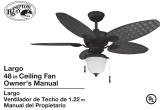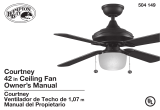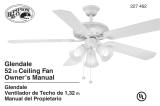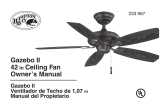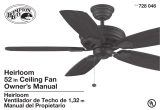Page is loading ...

36” San Marino
Ceiling Fan by Hampton Bay
3-Speed Reverse Function for
Year-Round Comfort and Savings
Steeper Blade Pitch for
Greater Air Movement
Tri-Mount Installation
Accu-Arm™ for Accurate and
Easy Installation
QUESTIONS, PROBLEMS, MISSING PARTS:
Before returning to your local Home Depot, please call our
Customer Service Team at 1-877-527-0313 or visit www.homedepot.com.
Please reference your SKU (666-834 brushed steel)
or UPC (82392 876531 brushed steel)
Thank you for purchasing this Hampton Bay ceiling
fan. This product has been manufactured with the
highest standards of safety and quality. The nish
of this fan is weather resistant, but over time will
naturally weather and fade.
Safety Rules .................................. 1
Unpacking Your Fan .................... 2
Installing Your Fan ...................... 3
Operating Your Fan ..................... 10
Care of Your Fan .......................... 11
Troubleshooting ............................ 11
Specications ................................ 12
Warranty Information ................. 13
Table of Contents

Safety Rules .................................. 1
Unpacking Your Fan .................... 2
Installing Your Fan ...................... 3
Operating Your Fan ..................... 10
Care of Your Fan .......................... 11
Troubleshooting ............................ 11
Specications ................................ 12
Warranty Information ................. 13
1. To reduce the risk of electric shock, insure electricity has
been turned off at the circuit breaker or fuse box before be-
ginning.
2. All wiring must be in accordance with the National Electri-
cal Code and local electrical codes. Electrical installation
should be performed by a qualied licensed electrician.
3. WARNING: To reduce the risk of re or electric shock, do
not use this fan with any solid-state fan speed control de-
vice.
4. CAUTION: To reduce the risk of personal injury, use only
the screws provided with the outlet box.
5. The outlet box and support structure must be securely
mounted and capable of reliably supporting a minimum of
35 pounds. Use only UL Listed outlet boxes marked “FOR
FAN SUPPORT.”
6. The fan must be mounted with a minimum of 7 feet clear-
ance from the trailing edge of the blades to the oor.
7. Do not operate reversing switch while fan blades are in mo-
tion. Fan must be turned off and blades stopped before re-
versing blade direction.
8. Avoid placing objects in path of the blades.
9. To avoid personal injury or damage to the fan and other items,
be cautious when working around or cleaning the fan.
10. Do not use water or detergents when cleaning the fan or fan
blades. A dry dust cloth or lightly dampened cloth will be
suitable for most cleaning.
11. After making electrical connections, spliced conductors
should be turned upward and pushed carefully up into outlet
box. The wires should be spread apart with the grounded
conductor and the equipment-grounding conductor on one
side of the outlet box.
12. Electrical diagrams are for reference only. Light kits that are
not packed with the fan must be UL Listed and marked suit-
able for use with the model fan you are installing. Switches
must be UL General Use Switches. Refer to the instructions
packaged with the light kits and switches for proper assem-
bly. Use 9W CFL bulbs max (included).
13. All set screws must be checked and retightened where neces-
sary before installation.
Safety Rules 1.
READ AND SAVE THESE INSTRUCTIONS
TO REDUCE THE RISK OF PERSONAL INJURY, DO NOT BEND THE
BLADE BRACKETS (ALSO REFERRED TO AS (“FLANGES”) DURING
ASSEMBLY OR AFTER INSTALLATION. DO NOT INSERT OBJECTS IN
THE PATH OF THE BLADES.
PLEASE REMOVE RUBBER MOTOR STOPS ON THE BOTTOM OF THE
FAN BEFORE INSTALLING BLADES OR TESTING MOTOR.
TO REDUCE THE RISK OF FIRE, ELECTRIC SHOCK OR PERSONAL IN-
JURY, MOUNT FAN TO OUTLET BOX MARKED ACCEPTABLE FOR FAN
SUPPORT WITH THE SCREWS PROVIDED WITH THE OUTLET BOX.

a. Blade attachment hardware
(15 Screws, rubber washers pre-attached
to the bracket)
b. Mounting Hardware
(1 bolt, 1 clevis pin, 1 rubber gasket)
c. Electrical hardware &
Balancing Kit
(3 plastic wire connectors, 1 pull chain for
the fan, 1 pull chain for the light kit, blade
balancing kit).
6. Slide-On Mounting Bracket
and Mounting Hardware
7. Light Kit Fitter
8. Shade
9. Decorative Motor Collar Cover
10. CFL Bulb
11. Extra Switch Cap Cover
1. Fan Motor Assembly
2. Canopy
3. Blades (5)
4. Blade Bracket Set (5)
with motor screws pre-installed
5. Ball/Downrod Assembly
2. Unpacking Your Fan
IMPORTANT: THIS PRODUCT AND/OR COMPONENTS ARE COVERED
BY ONE OR MORE OF THE FOLLOWING U.S. PATENTS: 5,947,436;
5,988,580; 5,971,573; 6,010,306; 6,039,541; 6,046,416 AND OTHER
PATENTS PENDING
Unpack your fan and check the contents. You should have the following items:

Installing Your Fan 3.
Tools Required
Phillips screw driver, straight slot screw
driver, adjustable wrench, step ladder, and
wire cutters.
Mounting Options
If there isn’t an existing mounting box, then
read the following instructions. Disconnect
the power by removing fuses or turning off
circuit breakers.
Secure the outlet box directly to the building
structure. Use appropriate fasteners and
building materials. The outlet box and its
support must be able to fully support the
moving weight of the fan (at least 35 lbs.)
Do not use plastic outlet boxes.
Figures 1, 2, and 3 are examples of different
ways to mount the outlet box.
Outlet Box
Outlet Box
Recessed
Outlet Box
Ceiling
Mounting
Plate
Provide Strong
Support
Note: You may need a longer downrod to
maintain proper blade clearance when install-
ing on a steep, sloped ceiling. The maximum
angle allowable is 30˚. If the canopy touches
downrod, remove the decorative canopy
bottom cover and turn the canopy 180˚ before
attaching the canopy to the mounting bracket.
Outlet Box
To hang your fan where there is an existing
xture but no ceiling joist, you may need an
installation hanger bar as shown in Figure 4
(available at your Hampton Bay retailer).
TO REDUCE THE RISK OF FIRE, ELECTRIC
SHOCK OR PERSONAL INJURY, MOUNT
FAN ONLY TO AN OUTLET BOX MARKED
ACCEPTABLE FOR FAN SUPPORT AND
USE THE MOUNTING SCREWS PROVIDED
WITH THE OUTLET BOX. OUTLET BOXES
COMMONLY USED FOR THE SUPPORT OF
LIGHTING FIXTURES MAY NOT BE ACCEPT-
ABLE FOR FAN SUPPORT AND MAY NEED TO
BE REPLACED. CONSULT A QUALIFIED ELEC-
TRICIAN IF IN DOUBT.
Figure 1
Figure 2
Figure 4
Figure 3

Standard Ceiling Mounting
1. Remove the mounting bracket from the
canopy by loosening the four screws on
the top of the canopy. Remove the two
non-slotted screws and loosen the slotted
screws. This will enable you to remove the
mounting bracket.
2. Route the wires exiting the top of the fan
motor through the canopy and then through
the ball/downrod assembly (Figure 6).
3. Loosen, but do not remove, the 2 set
screws on the collar on the top of the mo-
tor housing.
4. Align the holes at the bottom of the down-
rod with holes in the collar on top of the
motor housing (Figure 6). Carefully insert
the bolt through the holes in the collar
4.
Hanging the Fan
REMEMBER to turn off the pow-
er. Follow the steps below to hang your
fan properly.
NOTE: This ceiling fan is supplied with two
types of hanging assemblies; the standard
ceiling installation using the downrod with
ball and socket mounting, and the “close-to-
ceiling” mounting. The “close-to-ceiling”
mounting is recommended in rooms with
less than 8-foot ceilings or in areas where
additional space is desired from the oor
to the fan blades. When using standard
downrod installation, the distance from the
ceiling to the bottom of the fan blades will be
approximately 12 inches. The “close-to-ceiling”
installation reduces the distance from the
ceiling to the bottom of the fan blades to
approximately 8 inches.
Once you have decided which ceiling
installation you will use, proceed with the
following instructions. Where necessary,
each section of the instructions will note the
different procedures to follow for the two
types of installation.
Figure 6
Motor Collar
Bolt
Tighten
Screw
Firmly
Locking
Pin
Ceiling
Canopy
Ball/Downrod
Assembly
Motor Wires
Motor Collar
Cover
Pin in Locked
Position
FAILURE TO PROPERLY INSTALL LOCKING PIN
AS NOTED IN STEP 4 COULD RESULT IN FAN
LOOSENING AND POSSIBLY FALLING.
Figure 5
Loosen but
Do Not
Remove
Remove
and downrod. Be careful not to jam bolt
against the wiring inside the downrod. In-
sert clevis pin and bend to ensure security,
as noted in the circle inset of Figure 6.
5. Tighten the two screws on top of the fan
motor rmly (Figure 6).

5.
Figure 8
Figure 9
FAILURE TO COMPLETELY TIGHTEN THE
THREE SCREWS IN STEP 6 COULD RESULT IN
FAN LOOSENING AND POSSIBLY FALLING.
“Close-to-Ceiling” Mounting
1. Remove the mounting bracket from the
canopy by loosening the four screws on the
top of the canopy. Remove the two non-
slotted screws and loosen the slotted screws.
This will enable you to remove the hanger
bracket (Figure 5).
2. Remove the decorative canopy bottom cov-
er from the canopy by depressing the three
studs (Figure 7).
3. Remove three of the six screws and lock-
washers (every other one) securing the re-
inforcing plate to the top of the fan motor
housing (Figure 8).
4. Place the rubber gasket over the remaining
three screws, route the wires exiting the top
of the fan motor through the ceiling cano-
py over the collar at the top of the motor
(Figure 9).
5. Align the mounting holes with the holes
in the motor and fasten, using the three
screws and lock-washers removed in step 3
(Figure 9).
6. Tighten the mounting screws securely.
Figure 7
Canopy
Bottom
Cover

6.
Installing Fan to
the Outlet Box
1. Pass the 120-volt supply wires through the
center hole in the ceiling mounting bracket
as shown in Figure 10.
2. Install the ceiling mounting bracket on the
outlet box by sliding the mounting bracket
over the two screws provided with the outlet
box. When using close-to-ceiling mounting,
it is important that the mounting bracket be
level. If necessary, use leveling washers (not
included) between the mounting bracket and
the outlet box. Note that the at side of the
mounting bracket is toward the outlet box
(Figure 10).
120V Wires
Ceiling
Mounting
Bracket
UL Listed
Outlet Box
Slide Mounting
Bracket Over
Screw Heads
Hook
Mounting
Screws
(Supplied With
Outlet Box)
Figure 10
Figure 11
WHEN MOUNTING THE FAN ON A SLOPED
CEILING, THE STANDARD BALL/DOWNROD
MOUNTING METHOD MUST BE USED. MAKE
SURE THE MOUNTING BRACKET SLOTS ARE
ON THE LOWER SIDE BY SLIDING THE MOUNT-
ING BRACKET FROM THE TOP DOWN.
THE HOOK AS SHOWN IN FIGURE 11 IS ONLY
TO BALANCE FAN WHILE ATTACHING WIRING.
FAILURE TO HANG AS SHOWN IN FIGURE 11
MAY RESULT IN HOOK BREAKING, CAUSING
THE FAN TO FALL. HOOK MUST PASS FROM
INSIDE TO OUTSIDE OF CANOPY
LOCKING SLOTS OF CEILING CANOPY ARE
PROVIDED ONLY AS AN AID TO MOUNTING.
DO NOT LEAVE FAN ASSEMBLY UNATTENDED
UNTIL ALL FOUR CANOPY SCREWS ARE EN-
GAGED AND FIRMLY TIGHTENED.
TO REDUCE THE RISK OF FIRE, ELECTRIC
SHOCK OR OTHER PERSONAL INJURY, MOUNT
FAN ONLY TO AN OUTLET BOX MARKED AC-
CEPTABLE FOR FAN SUPPORT AND USE THE
MOUNTING SCREWS PROVIDED WITH THE
OUTLET BOX.
3. Securely tighten the two mounting screws.
4. Carefully lift the assembly up to the ceiling
mounting bracket and hang the fan on the
hook provided by utilizing one of the holes
at the outer rim of the ceiling canopy (Fig-
ure 11). If using standard mounting, seat the
hanger ball in the mounting bracket socket.
Make sure the tab on the mounting bracket
socket is properly seated in the groove in the
hanger ball (Figure 11).
Close-to-Ceiling
Mounting
Standard Mounting
WHEN USING THE STANDARD BALL/DOWN-
ROD MOUNTING, THE TAB IN THE RING AT THE
BOTTOM OF THE MOUNTING BRACKET MUST
REST IN THE GROOVE OF THE HANGER BALL.
FAILURE TO PROPERLY SEAT THE TAB IN THE
GROOVE COULD CAUSE DAMAGE TO WIRING.

Making the Electrical
Connections
REMEMBER to disconnect the power. If
you feel you do not have enough electrical
wiring knowledge or experience, have your fan
installed by a licensed electrician.
Follow the steps below to connect the fan
to your household wiring. Use the wire
connecting nuts supplied with your fan. Se-
cure the connectors with electrical tape.
Make sure there are no loose strands or
connections.
1. Connect the ground conductor of the 120v
supply (this may be a bare wire or a wire
with green colored insulation) to the green
ground lead(s) of the fan (Figure 12). When
using standard ceiling mounting, there are
two green grounding leads; one from the
ceiling mounting bracket and one from
the ball/downrod assembly. When using
“Close-to-Ceiling” mounting, there is only
one green ground lead from the ceiling
mounting bracket since the ball/downrod
assembly is not used.
7.
Figure 12
TO REDUCE THE RISK OF FIRE OR ELECTRIC
SHOCK, DO NOT USE A SOLID STATE SPEED
CONTROL WITH THIS FAN. IT WILL PERMANENT-
LY DAMAGE THE ELECTRONIC CIRCUITRY.
CHECK TO SEE THAT ALL CONNECTIONS ARE
TIGHT, INCLUDING GROUND, AND THAT NO
BARE WIRE IS VISIBLE AT THE WIRE NUTS, EX-
CEPT FOR THE GROUND WIRE.
ELECTRICAL DIAGRAMS ARE FOR REFERENCE
ONLY. OPTIONAL USE OF ANY LIGHT KIT SHALL
BE UL LISTED AND MARKED SUITABLE FOR
USE WITH THIS FAN.
BLUE
BLACK
WHITE
GREEN
WHITE
BLACK
BLUE
BLACK
WHITE
WHITE
Outlet
Box
Green
Grounding
Lead
Ground
to
Downrod
SUPPLY CIRCUIT
2. Connect the fan motor white wire to the
supply white (neutral) wire using a wire nut
(Figure 12).
3. Connect the fan motor black wire to the sup-
ply (hot) wire using a wire nut (Figure 12).
4. Connect the blue wire for the light kit to the
black household supply wire.
5. Turn wire nut connections upward, spread-
ing them apart so the green (ground) and
white wires will be on one side of the outlet
box and the black and blue wires will be on
the other side, and push into the outlet box.

8.
Finishing the Fan
Installation
STANDARD CEILING MOUNTING
1. Align the locking slots of the ceiling canopy
with the two screws in the mounting bracket.
Push up to engage the slots and turn clock-
wise to lock in place. Immediately tighten
the two mounting screws rmly.
2. Install the remaining two mounting
screws into the holes in the canopy and
tighten rmly.
3. You may now proceed to attaching the
fan blades.
CLOSE-TO-CEILING MOUNTING
1. Carefully unhook the fan from the mount-
ing bracket and align the locking slots of the
ceiling canopy with the two screws in the
mounting bracket. Push up to engage the
slots and turn clockwise to lock in place.
Immediately tighten the two mounting
screws rmly.
2. Install the remaining two mounting screws
into the holes in the canopy and tighten
rmly.
3. You may now proceed to attaching the fan
blades.
WHEN USING THE STANDARD BALL/DOWN-
ROD MOUNTING, THE TAB IN THE RING AT THE
BOTTOM OF THE MOUNTING BRACKET MUST
REST IN THE GROOVE OF THE HANGER BALL.
FAILURE TO PROPERLY SEAT THE TAB IN THE
GROOVE COULD CAUSE DAMAGE TO WIRING.
LOCKING SLOTS OF CEILING CANOPY ARE
PROVIDED ONLY AS AN AID TO MOUNTING.
DO NOT LEAVE FAN ASSEMBLY UNATTENDED
UNTIL ALL FOUR CANOPY SCREWS ARE EN-
GAGED AND FIRMLY TIGHTENED.
PLEASE REMOVE RUBBER MOTOR STOPS ON
THE BOTTOM OF THEFAN BEFORE INSTALL-
ING BLADES OR TESTING MOTOR.
Attaching the
Fan Blades
NOTE: Your fan blades are reversible. Select
the blade side nish that best accentuates your
decor.
1. Attach blade to blade bracket using the
screws provided as shown in Figure 13.
Please note that the rubber washers are pre-
attached to the blade bracket. Insert a screw
into the bracket. Repeat for the two remain-
ing screws.
2. Tighten each screw securely.
3. Fasten the blade assembly to the motor by
inserting the alignment post into the slot
on the bottom of the motor and tightening
the motor screws. Please note that the mo-
tor screws are pre-attached into the blade
bracket (Figure 14).
4. Repeat steps 1-3 for the remaining blades.
Blade
Mounting screw
Blade
bracket
Pre-attached
rubber pad
Figure 13
Figure 14

9.
Figure 15
Attaching the Light Kit
REMEMBER to disconnect the power.
1. Remove the three mounting screws on the
light kit tter.
2. Connect the wires exiting the bottom of the
motor with the light kit by connecting the
molded adaptor plugs together.
3. Slide the light kit tter into the switch cup
and secure it using the three screws that
were removed in step 1.
4. Insert the shade into the shade holder and
turn it clockwise to lock in place. Repeat for
the remaining shade.
5. With the power off, insert the 9W CFL light
bulbs (included) into the light kit sockets.
Max 9 watts.
Blade Balancing
All blades are grouped by weight. Because nat-
ural woods vary in density, the fan may wobble
even though the blades are weight matched. The
following procedure should correct most fan
wobble. Check after each step.
1. Check that all blade and blade bracket
screws are secure.
2. Most fan wobble problems are caused when
blade levels are unequal. Check this level by
selecting a point on the ceiling above the tip
of one of the blades. Measure from a point
on the center of each blade to the point on the
ceiling. Measure this distance as shown in
Figure 15. Rotate the fan until the next blade
is postioned for measurement. Repeat for
each blade. Measurement deviations should
within 1/8”. Run the fan for 10 minutes.
3. Use the enclosed Blade Balancing Kit if the
blade wobble is still noticeable.
Touching
Ceiling
Non-Light Kit Option
1. Remove the three mounting screws on the
black bracket below the motor.
2. Disconnecting the two wire connectors for
light kit. Remove the capacitor & switches
set from switch cap by removing the knurl
nut of speed switch and two screws of re-
verse switch.
3. Replace the capacitor & switches set to ex-
tra switch cap using the knurl nut of speed
switch and two screws of reverse switch re-
moved in step 2.
4. Connect the wires existing the bottom of the
motor with the fan control system, which is
inside the switch cap, by connecting the
molded adaptor plugs together.
5. Slide the switch cap up and secure the
switch cup to the black bracket using the
three screws that were removed in step 1.
RISK OF ELECTRIC SHOCK , THE CONNEC-
TORS PROVIDED IN A CEILING FAN FOR SUP-
PLYING POWER TO AN OPTIONAL LIGHT KIT
SHOULD NOT BE REMOVED UNLESS A LIGHT
KIT WILL BE IMMEDIATELY INSTALLED AND
THAT POWER SHOULD BE TURNED OFF PRIOR
TO CONNECTOR REMOVAL AND LIGHT KIT IN-
STALLATION.

Turn on the power and check the operation
of the fan. The pull chain controls the fan
speeds as follows: 1 pull - High, 2 pulls -
Medium, 3 pulls - Low and 4 pulls - Off
Speed settings for warm or cool weather
depend on factors such as room size, ceil-
ing height, number of fans, and so on.
The side switch controls the direction: for-
ward (switch up) or reverse (switch down).
10. Operating Your Fan
TO REDUCE THE RISK OF PERSONAL INJURY,
DO NOT BEND THE BLADE HOLDERS WHILE
INSTALLING, BALANCING THE BLADES, OR
CLEANING THE FAN. DO NOT INSERT FOREIGN
OBJECTS BETWEEN ROTATING BLADES.
Figure 16
Figure 17
WAIT FOR FAN TO STOP BEFORE REVERSING
THE DIRECTION OF BLADE ROTATION.
Warm weather - (Forward) A downward
air ow creates a cooling effect as shown
in Figure 16. This allows you to set your
air conditioner on a higher setting without
affecting your comfort.
Cool weather - (Reverse) An upward air
ow moves warm air off the ceiling are as
shown in Figure 17. This allows you to set
your heating unit on a lower setting with-
out affecting your comfort.

Care of Your Fan & Troubleshooting 11.
Care of Your Fan
Here are some suggestions to help you
maintain your fan.
1. Because of the fan’s natural movement,
some connections may become loose.
Check the support connections, brackets,
and blade attachments twice a year. Make
sure they are secure. (It is not necessary to
remove fan from ceiling.)
2. Clean your fan periodically to help maintain
its new appearance over the years. Do not
use water when cleaning, this could damage
the motor, or the wood or possibly cause
an electrical shock. Use only a soft brush
or lint-free cloth to avoid scratching the
nish. The plating is sealed with a lacquer
to minimize discoloration or tarnishing.
Warning - Make sure the power is off
before cleaning your fan.
3. You can apply a light coat of furniture pol-
ish to the wood for additional protection
and enhanced beauty. Cover small scratches
with a light application of shoe polish.
4. There is no need to oil your fan.
The motor has permanently lubricated
sealed ball bearings.
MAKE SURE THE POWER IS OFF AT THE ELECTRICAL PANEL BOX BE-
FORE YOU ATTEMPT TO MAKE ANY REPAIRS. REFER TO THE SECTION,
“MAKING ELECTRICAL CONNECTIONS.”
Fan will not start
Fan sounds noisy
1. Check main and branch circuit fuses or breakers
2. Check line wire connections to the fan and switch wire connections in
the switch housing. CAUTION: Make sure main power is off.
1. Make sure all motor housing screws are snug.
2. Make sure the screws that attach the fan blade bracket to the motor hub
are tight.
3. Make sure wire nut connections are not rattling against each other or
the interior wall of the switch housing. CAUTION: Make sure power
is off.
4. Allow a 24-hour “breaking in” period. Most noises associated with a
new fan disappear during this time.
5. If using the Ceiling Fan light kit, make sure the screws securing the
glassware are tight. Check that the light bulb is also secure.
6. Make sure the canopy is a short distance from the ceiling.
It should not touch the ceiling.
7. Make sure your outlet box is secure and rubber isolator pads were used
between the mounting bracket and outlet box.
Troubleshooting
Problem Solution

12. Specications
FAN SIZE SPEED VOLTS AMPS WATTS RPM CFM N.W. G.W. C.F.
36”
Low 120 0.21 13 80 1450
12.54
Lbs
14.19
Lbs
0.98Med 120 0.3 26 135 2200
High 120 0.42 49 205 3200
These are approximate measures. They do not include Amps and Wattage used by the light kit.
Distributed by Home Depot U.S.A., Inc.
2455 Paces Ferry Rd. N.W. Atlanta, Georgia 30339
Vendor number: 11688

Hampton Bay Lifetime Limited Warranty
Lifetime Warranty on Motor
Hampton Bay warrants the fan motor to be free from defects in workmanship and material present at
time of shipment from the factory for a lifetime after the date of purchase by the original purchaser.
Hampton Bay also warrants that all other fan parts, excluding any glass or acrylic blades, to be free
from defects in workmanship and material at the time of shipment from the factory for a period of
one year after the date of purchase by the original purchaser. We agree to correct such defects without
charge or at our option replace with a comparable or superior model if the product is returned to
Hampton Bay. To obtain warranty service, you must present a copy of the receipt as proof of purchase.
All costs of removing and reinstalling the product are your responsibility. Damage to any part such
as by accident or misuse or improper installation or by afxing any accessories, is not covered by
this warranty. Because of varying climatic conditions, this warranty does not cover any changes in
plated nishes, including rusting, pitting, corroding, tarnishing or peeling. Brass nishes of this type
give their longest useful life when protected from varying weather conditions. A certain amount of
“wobble” is normal and should not be considered a defect. Servicing performed by unauthorized
persons shall render the warranty invalid. There is no other express warranty. Hampton Bay hereby
disclaims any and all warranties, including but not limited to, those of merchantability and tness
for a particular purpose to the extent permitted by law. The duration of any implied warranty which
cannot be disclaimed is limited to the time period as specied in the express warranty. Some states
do not allow limitation on how long an implied warranty lasts, so the above limitation may not apply
to you. Hampton Bay shall not be liable for incidental, consequential, or special damages arising
out of or in connection with product use or performance except as may otherwise be accorded by
law. Some states do not allow the exclusion of incidental or consequential damages, so the above
exclusion or limitation may not apply to you. This warranty gives specic legal rights, and you may
also have other rights which vary from state to state. This warranty supersedes all prior warranties.
Shipping costs for any return of product as part of a claim on the warranty must be paid by the
customer.
IMPORTANT NOTE:
To ensure warranty service, if ever
necessary, please register your fan at:
gpwarranty.com
You must present a copy of the original
purchase receipt to obtain warranty service.
G.P. WARRANTY SERVICE CENTER, INC.
WARRANTY SECTION
1951 N.W. 22nd STREET
FORT LAUDERDALE, FLORIDA 33311
Attach receipt here for
easy location.

6.
Cómo instalar el
ventilador en
la caja eléctrica
1. Pasa los cables de 120 voltios a través del
oricio central en el soporte de montaje de
techo como lo muestra la gura 10.
2. Instala el soporte de montaje de techo so-
bre la caja eléctrica deslizando el soporte
de montaje sobre los dos tornillos sumin-
istrados con la caja eléctrica. Cuando uses
el montaje cerca del techo, es importante
que el soporte de montaje esté nivelado. Si
es necesario, usa arandelas niveladoras (no
incluidas) entre el soporte de montaje y la
caja eléctrica. Nota que el lado plano del
soporte de montaje está hacia la caja eléc-
trica (gura 10).
3. Ajusta rmemente los dos tornillos de
montaje.
Figura 10
Figura 11
CUANDO MONTES EL VENTILADOR EN UN
TECHO INCLINADO, DEBES USAR EL MÉTODO
DE MONTAJE CON TUBO BAJANTE Y BOLA
ESTÁNDAR. ASEGÚRATE DE QUE LAS RANU-
RAS DEL SOPORTE DE MONTAJE ESTÉN EN EL
LADO INFERIOR DESLIZANDO EL SOPORTE DE
MONTAJE DESDE ARRIBA HACIA ABAJO.
EL GANCHO COMO SE MUESTRA EN LA FIG-
URA 11 SOLAMENTE ES PARA SOSTENER EL
VENTILADOR MIENTRAS SE CONECTAN LOS
CABLES. SI NO SE CUELGA COMO SE MUES-
TRA EN LA FIGURA 11, PUEDE ROMPERSE EL
GANCHO, Y EL VENTILADOR SE CAERÁ. EL
GANCHO DEBE PASAR DE ADENTRO HACIA
FUERA DE LA CUBIERTA.
LAS RANURAS DE CIERRE DE LA CUBIERTA DE
TECHO SÓLO SON UNA AYUDA PARA HACER
EL MONTAJE. NO DEJES SIN SUPERVISIÓN EL
ENSAMBLE DEL VENTILADOR HASTA QUE LOS
CUATROS TORNILLOS DE LA CUBIERTA SE FI-
JEN Y APRIETEN FIRMEMENTE.
PARA REDUCIR EL RIESGO DE INCENDIO,
DESCARGA ELÉCTRICA O LESIONES PER-
SONALES, MONTA EL VENTILADOR SÓLO SO-
BRE UNA CAJA ELÉCTRICA MARCADA COMO
“APROBADA COMO SOPORTE DE VENTILA-
DOR” Y USA TORNILLOS DE MONTAJE QUE
VIENEN CON LA CAJA ELÉCTRICA.
4. Con cuidado levante el ensamble hacia el
soporte de montaje del techo y cuelgue el
ventilador del gancho suministrado usando
uno de los oricios en el borde exterior de
la cubierta de techo (Figura 11). Si usas el
montaje estándar, asienta la bola de sopo-
rte en el casquillo del soporte de montaje.
Asegúrate de que la pestaña sobre el cas-
quillo de soporte de montaje encaje bien
dentro de la ranura de la bola de soporte.
(Figura 11).
CUANDO USES EL MONTAJE DE TUBO BA-
JANTE Y BOLA ESTÁNDAR, LA PESTAÑA EN
EL ARO EN LA PARTE INFERIOR DEL SOPORTE
DE MONTAJE DEBE ENCAJAR EN LA RANURA
DE LA BOLA DE SOPORTE. SI NO ENCAJA
CORRECTAMENTE, SE PUEDE DAÑAR EL
CABLEADO.
/
